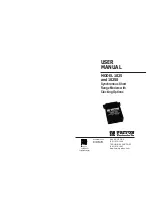
PN 88300150
4/3/01
27
3.8
Immediate Action Commands
$H
Help Screens
The $H command gives you short explanations on how to use each MT2834MR command.
The $H command can be quite useful if your manual is not handy and you are in the middle
of a communications session. Although the explanations are quite abbreviated compared to
those in this manual, they should prove to be helpful reminders when needed.
At the time of this writing, we have three screens of Help information (Screen #1, #2 and #3),
and more screens may be added in the future. The Help commands are structured so that
you can call up one of three Help screens, as follows:
AT$H1 = Help Screen #1
AT$H2 = Help Screen #2
AT$H3 = Help Screen #3
+++AT<CR>
Escape Sequences -- Entering Command Mode While Still On-Line
It is possible to cause the MT2834MR to enter the Command mode after the modem has
gone on-line with a remote modem, without disconnecting the call. This is accomplished by
typing an Escape Code. The default Escape Code used by the MT2834MR is three plus
signs (+++) followed by the letters A and T, up to sixty command characters (most typically H,
to hang up), and an ENTER. The number of command characters allowed after +++AT<CR>,
is defined by S-Register S34. S-Register S34 defaults to ten command characters. When this
is done, the modem will escape to Command mode, execute the command (if any), and then
remain in Command mode. For example, to hang up the modem at the end of a call, the
command would be +++ATH followed by ENTER. There is no need to incorporate pauses
before and after the plus signs, as done in earlier modems.
BREAK AT<CR>
The MT2834MR provides an alternative Escape method, using a Break signal as the Escape
Code. The Break signal allows the start-stop DTE (data terminal equipment) to signal the
modem without loss of character transparency. With this method, a BREAK signal is used
instead of the three plus signs. The BREAK is followed by the letters A and T, up to 60
command characters, and ENTER. When this is done, the modem will execute that
command, but remain in the normal On-Line mode unless the command was to hang up
and/or reset the modem (an H or Z), in which case the modem would be in the Command
mode after executing that command.
*
Readers interested in further information on the use of BREAK signals as escape codes may wish to consult the ITU-T X.28
Recommendation. In the “Provisional Recommendation X.28 (Geneva 1977)”, information on the topic can be found in Section
4.9, entitled “Escape from the data transfer state”. More recent editions have been published in 1980, 1984 and 1988. ITU-T
publications can be obtained from Omnicom, Inc., 112 Park Street SE, Vienna, VA 22180, Phone 703/281-1135, FAX 703/281-
1505.
%E
Escape Sequence Options -- Entering Command Mode While On-Line
As mentioned, the default setting is for the modem to respond to the +++ escape method.
Optional settings are for the modem to respond to the BREAK method, for the modem to
respond to either the +++ or the BREAK Methods, and for the modem to ignore both methods
and not escape. The %E command is used to select these options, as follows:
%E0 = Modem Won’t Escape
%E1 = +++AT<CR> Method (factory default setting)
%E2 = BREAK Method
%E3 = Either +++ or BREAK Methods
%E4 = Disable OK response to +++
%E5 = Enable OK response to +++
Содержание MT2834MR
Страница 1: ...PN 88300150 4 3 01 1 MT2834MR MT2834MRI and MT2834MRK Owner s Manual ...
Страница 104: ...PN 88300150 4 3 01 104 Appendix L MT2834MRI PC Board MT2834MRI PCB Top ...
Страница 105: ...PN 88300150 4 3 01 105 MT2834MRI PCB Chassis 2 ...
Страница 106: ...PN 88300150 4 3 01 106 MT2834MRI Labels ...
















































